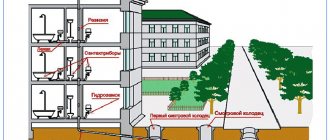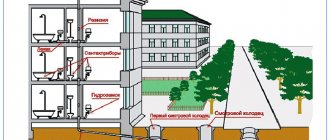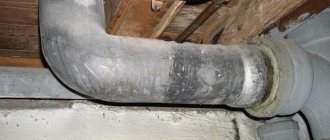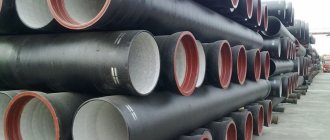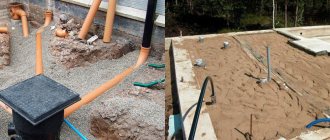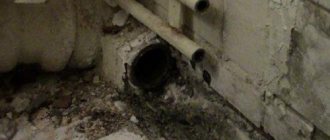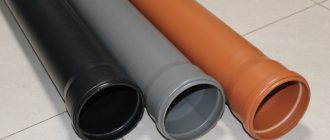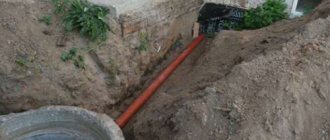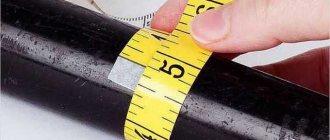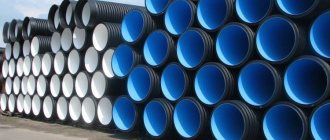Methods
If you have such an obstacle in the sewer, you can use the following methods, each of which is capable of one or another
Effectively rid the toilet of a plug:
- fully repay the debt for services to public utilities (then the sewer plug will be officially removed);
- pull it out with your own hands by dismantling the toilet, or dismantling part of the sewer pipe;
- use chemicals (they are poured through an open inspection, if there is one).
With the first option, everything is clear - here you only need to deposit money. For the rest, prepare the following tools:
- a hook or metal hook with a long handle;
- hammer;
- flashlight (preferably small);
- wrenches or adjustable;
- pliers.
The use of chemicals can result in clogging of the entire riser, which will deprive your neighbors of the opportunity to use the sewer. They definitely won’t say “thank you” to you for this.
When trying to remove a drain blocker yourself, keep in mind that no one can give you a 100% guarantee of a favorable outcome.
Installation of sewer plugs for debtors
So, a debtor drain plug prevents wastewater from flowing down the system.
When installing a plug, the utility service employees will not have any problems with other apartments: the device is installed in such a way that neighboring apartments are not affected, and the drainage of wastewater is stopped only for a specific apartment.
The plugs are different. They can be made from different materials, and there can be plenty of design differences in the models. Installing sewer plugs is a fairly technologically advanced task, the implementation of which became available relatively recently.
Sometimes owners think that the drain is simply clogged and are looking for ways to break through the blockage in the toilet. But in such cases it does not help.
The stub installation algorithm is as follows:
- First, a specially trained company employee or hired specialist studies the sewerage connection diagram in a given apartment. This is done for the following reason: in individual apartments several risers are often installed, and one sewer plug for defaulters will not get rid of the problem.
- Once the diagram has been studied, the specialist begins to develop a plan for installing the plug. The key goal is to understand in what specific location the debtor's sewer plug should be installed. As a rule, such a pipe is the main riser of the apartment, located between the sewer line and the toilet.
- Then you need to find a convenient place from which it will be convenient to control your equipment. Often, neighboring apartments or a drain pipe located on the roof are used for this.
- A manipulator, a camera and a light guide are launched into the pipe. The operator controls these elements and moves the plug to the designated location. Next, it is inserted into a side branch and installed in the pipe.
After installing the plug, the movement of wastewater from the apartment stops, sometimes completely, and sometimes partially. All other risers are working, and the sewer system for all other apartments continues to function.
It must be said that a large number of companies are engaged in installing and removing plugs. In general, there is not much difference, since the cost of such services and their quality are at the same level.
What is a sewer plug
Given the number of defaulters and their rights, many utility companies have to get very creative to get people to pay. Of course, the simplest and most affordable method of turning off a tenant who does not pay for water is to turn it off in this apartment. The problem is that in apartment buildings, water is supplied through a single riser, which can only be shut off entirely - and this will immediately lead to outrage from conscientious citizens. Therefore, blocking the sewer system for debtors is carried out using other methods.
You can shut off the water supply to one apartment from the inside, but anyone can refuse to allow inspectors into their home, and they will be absolutely right: the current law stipulates this point, saying that housing is inviolable.
The solution that the companies have developed is extremely simple: if it is impossible to shut off the water in one apartment, then in this apartment you can block the sewerage system by simply installing a plug. Since such a solution is completely legal, it is not surprising that it is actively used.
Plugs can be very different, depending on their purpose:
- solid: such a plug on the sewer pipe will completely stop the movement of waste into the central sewer;
- lattice: liquid will pass freely further, but solid waste will remain at the level and will gradually accumulate.
Repeating what was said above, we can say that installing sewer plugs for debtors fully complies with the law: the company must service the apartment, but must not enter it.
This rule is followed, the defaulter experiences unpleasant feelings, and the company waits for the bills to be paid. The result is a very unpleasant result: one resident produces about two hundred liters of waste per day. Of course, such a volume will very quickly be enough to get from the remaining part of the riser to the apartment itself. Typically, installing a plug on a sewer pipe results in bills being paid within a couple of days.
How to remove
Turning off the sewer system is rarely required, but situations may arise in which it is necessary to remove the plug to ensure the sewer system is connected to the house or apartment
It is important to understand this procedure to ensure perfect results.
How to remove a plug from a sewer? This process depends on which element you are dealing with:
- if a rubber plug is installed, it is simply pierced, for which any cutting tool is used. The element has thin and soft walls, so there are no problems with its deformation. To do this, a metal and sharp tool is lowered into the pipe using a plumbing cable. After cutting the rubber plug, it deflates and simply falls out of the system;
- if there is a product made of plastic or metal, then it is quite easy to move it in any direction, and this process is carried out either manually or using standard pliers. It is advisable to pull it out so that it does not remain in the system. To do this, just tighten the stop of the plug. If it is not possible to pull it out of the pipe, then it must be fixed with a spacer so that it is not washed away by wastewater;
- It is often impossible to move hard metal or plastic plugs. In this case, a hole is formed in the riser, and in such a way that it is at a convenient angle to the plug. A metal pin is inserted into the resulting hole until it hits the product. You need to hit it with a hammer to move the plug;
- in a plastic element it is enough to simply make a hole with a sharp knife, and a core drill is often used for these purposes. It is not recommended to use this method for metal products because they are springy. Therefore, it is most optimal for them to use an angle grinder. The cut elements are simply pulled out of the system;
- if there is a lattice structure, then you just need to saw or cut through the existing rods.
If the work must be performed by the owner of an apartment located on the top floor of an apartment building, then access to the pipes is easy to obtain through the roof or attic of the building.
You can even remove the plug from the sewer yourself using chemical methods. For this purpose, special products containing oxalic or hydrochloric acid are used. However, in reality, this method is characterized by low efficiency and effectiveness.
Also, when using aggressive chemicals, there is a high probability of causing irreparable damage to the pipes themselves. The products begin to work after several days of use, so the process is delayed for a long time.
If you perform the process carefully and efficiently, you can use the plug again for another section of the sewer system.
Thus, sewer plugs are effective and efficient tools that allow you to block the sewer riser if necessary. They are represented by several types, differing in installation principles, service life and production material.
Their installation is a rather complex and specific job that requires specialized equipment.
If you need to remove an element, then it is important to figure out which method for these purposes will be the most optimal and effective, and its choice depends on the type and installation features of each structure
If you take the work responsibly and seriously, then there is a high probability of receiving a high-quality element that can be reused after dismantling.
Methods for removing plugs
You need to immediately understand the following point: pneumatic plugs for sewage systems cannot be removed with chemicals. The reason is simple: the same materials from which the pipes are made are used to make the plugs, therefore, by destroying the obstacle, the sewage system in the apartment building is also destroyed - and its repair can cost much more than paying off the debts.
Thus, the most affordable method of removing the plug is to use mechanical methods. This is the most correct answer to the question of how to remove a plug from a sewer. Naturally, the plug stays in the pipe more firmly than a floor rag that gets there, but sufficient effort should be enough.
So, the first and most accessible method involves removing sewer plugs for debtors with a plunger.
How does this happen:
- Before you remove the plug from the sewer yourself, you need to understand where the plug is located. To do this, it will be enough to tap the pipeline: in filled places the sound will be dull, and in empty places it will be ringing.
- If the sewer system was not used after installing the plug, then you need to find a plumbing fixture located as close as possible to the main line.
- Now you need to run water in this device and wait until it reaches the drain grate.
- The plunger is installed above the grate, after which it must be pumped several times to create increased pressure in the system. Water is not compressible, so the pressure will cause it to act on the plug, forcing it out of the system.
If the installation of the plug in the sewer was performed poorly, then these actions will be enough to solve the problem. The only thing you should always remember before removing a plug from the sewer yourself is that a fallen plug can get stuck in the main, after which the use of the sewer will be closed to all residents.
If the plunger does not help, then you can use a plumbing cable, which is also a good way to remove the plug on the sewer pipe. More information about using a plumbing cable can be found in articles dedicated to this device. In short, a plumbing cable will allow you to remove the plug and push it out, resulting in the drain being cleared. In addition, you can make a plumbing cable with your own hands, which will simplify the task.
As a last resort, if all else fails, you can dismantle part of the sewer and get to the right place. Sometimes even this method allows you to fix the problem without any problems. Conclusion
The fight between defaulters and utility companies has been going on for quite some time, and both sides are constantly coming up with new methods to fight each other. The plug on the sewer pipe is installed using high technology, but residents respond no less inventively. Be that as it may, it is always much better to pay all bills on time and sleep peacefully.
Types of sewerage closures
Utility service provider companies independently decide the extent to which they can restrict access of defaulters to the sewer system. When apartment drainage systems exit to 2 or more risers, a plug can be installed on one pipeline (with fecal waste), leaving the water supply free.
Plugs for sewer pipes are also multi-variant. There are solid and lattice.
- Solid. The most radical way to solve the problem. Utilities completely shut down the sewer system. With zero drainage, it is difficult for apartment residents to ensure normal life activities.
- Lattice. With their help, the debtors' sewerage system is not completely turned off. Liquid fractions pass freely into risers. Solid organic matter will remain in the pipe. As the water line becomes clogged, the flow of water will also become worse. This method allows the tenant to defer payment of the debt.
How to place
Permanent plugs are installed during the installation of the system during the construction of a house. To do this, a tee connection or outlet is mounted in the required location, and a plug is inserted into the socket.
The plug is also placed in the inspection window in the pipe riser so that it can be pulled out at the right time. The main purpose is to provide easy access to the pipe trunk during cleaning or work with the sewer.
Another task solved by the shutter is the temporary cutting off of some sections of the pipeline that will be worked on in the future, as well as preventing unwanted odors.
Temporary plugs are installed both in the main pipeline to cut off a section of pipe and subsequent work with it, and in an apartment building to stop drainage in a specific apartment.
Alternative option
If the toilet is securely fixed to the floor or removing the plug from the sewer is impossible, but there is an inspection hatch, it makes sense to work through it. In this case, you need to be careful, because waste or hot water may pour from above; do not neglect protection. It's simple:
First, the inspection window or hatch opens. You need to have a harpoon or a long stick with a hook, which will need to be used to pick up the plug. There is a possibility that the tool will slip out of your hands and fall down, making it impossible to get it out.
Therefore, it is worth tying a rope to the end and leaving it outside so that you can intercept it if something happens. Carefully pry the plug and remove it. You need to act very carefully so that it does not fall and block the riser.
After completion of the work, the hatch must be closed and the plumbing installed in place.
Operating principle of the drainage blocking system
Which method of exposure to choose, turning off the lights or limiting water disposal, is decided based on specific conditions. Less hassle of cutting the light. When this cannot be done for some reason, the owner will face no less severe measures. This is the installation of a plug in a sewer riser. Why is this method chosen, and not turning off, for example, the same hot water that is permitted by law? The reason is in the design of utility networks. Of course, you can shut off the hot water riser, but this will leave all your neighbors without water. To turn off the water only to the debtor’s apartment, you need to enter his territory. It is easy to imagine what the debtor will answer when a locksmith calls him, offering to let him into the apartment, where he will turn off the hot water. At best, the plumber will have to listen to the owner’s non-literary monologue and instructions on which route to take. Therefore, a method was found to put pressure on non-payers by specifically blocking the sewer system using a plug. In this case, not a single apartment connected to the same riser as the debtor’s apartment will be affected. It is easy to understand how a stub works using the following example. Imagine many small streams running from the mountains and flowing into one river. If you block one stream with a dam, the others won’t care. They will also flow into the river; the dam will not stop them. A plastic plug installed in the sewer system works on the same principle.
Sewer plug design for non-payers
What does a formidable weapon in the fight against a debtor, a sewer plug, look like? Imagine an ordinary pipe with a diameter of 100 mm, about 20-30 cm long, cut in half lengthwise. One half of such a segment is that same stub. Its convex part is attached to the sewer outlet of the debtor's apartment, and the concave plug looks at the common riser, without interfering with the drains from other apartments being freely removed.
What does the sewer plug installation system consist of?
Equipment for blocking sewers for housing and communal services debtors is produced by different factories and manufacturers. This is not a cheap gadget, but management companies spend the money because the result justifies this expensive purchase. The kit for installing the plug includes:
shockproof control panel with monitor, it has a built-in battery, can work from the mains or autonomously;
a waterproof probe with two video cameras built into it, they work in any, even aggressive, environment;
DVR for recording video of installation or dismantling of the plug;
flexible hose for lowering the plug into the sewer system;
control panel and the plug itself.
The entire complex of work must be carried out by two people. It will take no more than 30 minutes to install the plug in one apartment.
Installing a drain plug
Before installing the plug, utility workers check the layout of the risers in the apartment, the number of risers, and the working condition of the sewerage system. If there is a blockage, you will not be able to install the plug. If the risers are in good condition, the debtor is notified that a sanction has been applied to him in the form of blocking the drains, you can proceed directly to the process of introducing a plug. Having climbed to the roof of the house, they determine the location of the drain pipe of the riser of the “bad” apartment. Through it, a plug attached to the probe is lowered to the debtor’s apartment. Its progress is monitored on the monitor. As soon as the plug reaches the sewer outlet from the debtor's apartment, the operator on the roof, using the control panel, disconnects it from the probe and the plug is inserted exactly along the cross-section of the outlet. The sewage drain from the debtor's apartment is blocked. The plug has a special retainer that helps it stay in the pipe opening and block the flow. You can also remove the plug using equipment. It will be difficult for the debtor to remove the interfering device on his own, although there are ways. True, they are labor-intensive. The easiest way to get rid of the stub is to pay off the debt. Within 1-2 days after repayment of the debt, utilities will restore sewerage.
The procedure for installing and removing a sewer plug
Almost all multi-storey buildings have a central riser that runs through all floors and ends in a vent pipe on the roof, which is necessary for ventilation and air access to the duct. Therefore, theoretically and practically, installing a plug through a pipeline from the roof to any apartment does not present any particular difficulties; operations are carried out in the following sequence:
- Using a special camera and lighting, the condition of the sewer riser (the surface of the inner shells of the pipes) in the overlap area is studied, and based on this, the type of plug is determined. At the same time, the material of manufacture of the riser is also taken into account - different types of plugs are installed on smooth polyvinyl chloride (PVC) plastic and cast iron pipes rough on the inside.
- Next, they begin to immerse the plug, models with sharp teeth are lowered into a PVC plastic pipe for fixation on smooth walls, and self-expanding structures are placed in cast iron risers.
- After the user pays the rent in full, representatives of the installation company return to the roof and lower the manipulator into the sewer shaft. An operator-controlled device compresses the sliding structure or releases air from the ball, after which it removes the plug to the surface.
Rice. 8 Placement of cylindrical plugs in the sewer tee
Principles and features of installation of various types of plugs
When screwing in the plug, it is important not to strip the thread.
The pipe jamming device can be installed in different ways depending on its design features. The following actions are performed:
- Screwing in. This method is used to install a threaded fitting. Before installing it, you must use fum tape and sealant. They will additionally protect the system from leakage. The tape is wound in a small layer on the outer part of the fitting and screwed on. The threaded plug is screwed in by hand until it stops, but without excessive tension.
- Welding. Suitable if an elliptical element is being installed. It is possible to achieve complete tightness of communication. In this case, the work should only be carried out by a specialist. The welded plug is installed for a long period and is not suitable if any repair work is expected to be carried out on the communication section in the near future.
- Use of bolts and nuts. This method is used to install a flange muffler. Before installation, you need to place a seal between the fitting and the pipe. It, in turn, is selected in accordance with the permissible temperature values for a particular system and the pressure requirements in it.
- Air injection. The water supply plug can be installed in several stages. Water is removed from the pipe, a hole is made in the desired section of the system, a fitting is inserted and air is pumped into it. Expanding, the walls of the plug fit tightly to the inside of the pipe. Remove the pneumatic fitting upon completion of the repair work. To do this, you just need to pump out the air from the rubber stopper and remove it.
Chemicals
At the moment, there are a large number of drain cleaning products containing oxalic or hydrochloric acid. They will be able to corrode the plug, but provided that it is iron, and the owner must have time and patience, since the result will be noticeable no less than seven days later.
Which method to choose depends on events and the availability of plumbing supplies. Mechanical intervention is a troublesome process, but the most effective. The chemical method of solving the problem is less effective, but is justified by its simplicity.
Installing plugs is an extreme measure that water utilities or communications companies should take. And if they become aware that the plug has been removed, they are more likely to reinstall it.
Comfortable use of the benefits of civilization is unrealistic without paying for them. Based on this, if you diligently pay for housing and communal services, then, under no circumstances, will you need to deal with the removal of plugs, doing hard, unclean, and from time to time, hopeless work.
Can utility workers turn off the sewer system?
Many citizens are interested in whether sewerage can be blocked for debts. The thing is that in the current version the direct ban on turning off the sewer system has been abolished. In this regard, management companies (MCs) that collect payments are now threatening defaulters with suspension of the resource supply.
It states that the only way to influence malicious debtors and non-payers of housing and communal services is to limit or suspend water drainage and water supply.
At the same time, in search of an answer to the question of whether housing and communal services can turn off sewerage, it is worth considering that the above-mentioned resolution contains an important condition, according to which the suspension of any type of utility services should not:
- damage the common property of residents of an apartment building;
- violate the rights of other owners, including the suitability of residential premises.
Therefore, if a consumer doubts whether the sewerage system in the house was legally turned off, you can go to court to stop interfering with the sanitary and technical condition of the apartment building equipment.
How to install the valve
Sewerage is closed as a last resort, when the resident has been repeatedly warned and utility services have been suspended.
- check the condition of the pipes;
- notify the debtor of the upcoming sewerage closure;
- provide a safe exit to the drain pipe;
- make sure there are no branches at the riser.
Management companies (MCs) do not have the right to install a plug without notification. If the employees of the management company did not warn the tenant about blocking the sewer drain, then the company’s actions can be challenged in court, and even if there is a debt, the court will make a decision in favor of the person who suffered from the work of the management company, who is obliged in this case to compensate for moral damage.
The debtor is notified by the housing and communal services services by sending him the appropriate paper, which must contain information about the restriction or suspension of wastewater disposal services if he does not repay the debt within 1 month after receiving this notification. It is handed over personally to the defaulter, who must sign upon receipt, or sent by registered mail.
If the debt is not repaid within the allotted time, the management company employees begin installing the plug:
- A specialist studies the layout of the sewer system to determine the number of drains that need to be blocked. If there are several drains, then valves are installed on all of them. When only one is blocked, residents can use the free ones.
- Select the type of plug and its installation location. In most cases, the installation location for the ceiling is the main riser, which runs from the general sewer system to the toilet.
- At the final stage, a camera, LEDs or a manipulator are placed in the sewer pipe. They are controlled by the operator, who installs the plug in the selected area.
Why install a plug on a sewer pipe?
Pipe plugs perform different functions.
The purpose of the plugs depends on their location. Such elements are installed when assembling the system. They are necessary in the following cases:
- Installation of the system with a reserve. In this case, we are talking about main pipes that remove sewage from the apartment. The architecture of the system, even within an apartment, can change. New devices and elements are added to it, and the configuration of the pipes changes. A simple example: installing a sewer system in an apartment. At the moment there is no washing machine in the bathroom, but there may be one later. A branch is made in the sewer pipe under the washing machine and a plug is attached to it. Until the device is attached, this thread will be closed. When it becomes necessary to connect a washing machine to the sewer, the plug can be removed.
- Construction of large highways with branches to new branches. Construction work is constantly going on in large cities. There are more houses, but it is difficult to constantly rebuild the sewer system for new buildings. To do this, even when installing the sewer system, spare dead-end branches are created, onto which plugs are attached. Their difference from household ones, which are used to change the sewer system within one apartment, is exclusively in their large size. If necessary, it is removed and the outlet is connected to the pipe system.
- Revision. The sewer system must function continuously. The problem is that sewage carries various impurities that can clog pipes. To remove blockages, access to various sections of the pipe is necessary. For access, blind bends are used, to which removable plugs are attached. If a blockage occurs, the plug can be removed, special tools inserted into the outlet, cleaned out the pipe, and then put back on.
- Overlapping a specific branch. In those places where main sewerage pipelines branch into smaller ones, plugs are needed. They will be needed if you need to shut off drains from individual parts of the system. For example, in the place where the pipeline from the apartment connects to a common riser, an outlet with a plug is required. In the event of an accident or repair work, plugs are installed and part of the system is turned off from operation.
Installation technology
Methods for installing plugs depend on what type was chosen. The most common are in the form of lids with a rubberized ring. Installing them does not require special skills. To do this, just select a plug of a suitable diameter. The material from which it is made must match the material of the pipe.
A rubberized ring is placed between the pipe and the plug, with an additional layer of sealant applied to it. This will increase the tightness of such a connection. Then put on the plug before the sealant hardens, pressing it tightly against the pipe. This completes the installation process.
It is important! When installing a regular plug, there is no need to worry about its tightness. The sewerage system is a non-pressure system. The pressure inside it is small, so the plug will not move during operation or leak liquid. The main advantage of such a plug is the speed of installation and dismantling.
Threaded plugs are screwed into pipes using threads. They can often be found on metal pipes. For sewerage, this type of connection is rarely used, despite the fact that it has greater tightness than a conventional plug without a thread.
We recommend that you read: Features of using a shut-off and control valve with an electric drive
Gate valves with flange connections are secured using special bolts. They are installed on large highways, where there is a need for these types of plugs.
Welded ones have the best tightness. To install them, you need a special pipe welding machine. The end of the pipe and the plug are inserted into the jaws of such a device, welding these parts to each other. This is a permanent type of plug, which is also non-removable. It is not often used for sewer systems.
Pneumatic plugs are used by utilities. These are parts that are made of dense rubber and inflated to increase in volume. In the deflated state, the plug is inserted into the pipe and advanced to the outlet of the final consumer of the service. It is inflated in the right place and it closes the lumen, tightly touching the walls of the pipe.
How difficult is it to remove the plug yourself?
As you might guess, when developing the impact method under consideration, utility services did everything in their power to prevent
remove the obstacle without their knowledge or consent.
Nevertheless, it is possible to fix it yourself, even if you are not a plumber.
You need to know that there are a number of factors that make work difficult. So:
- the plug is installed for non-payment using a special manipulator - this equipment is available only from the specialized service;
- to remove it in your apartment, you will need to remove the toilet;
- work (both in the old house and in the new building) is carried out blindly;
- During the extraction process, there is a high risk that sewage will spill directly onto your floor.
How legal is everything?
Smart and very attentive employees of enterprises serving apartment buildings quickly noticed a “hole” in the law on public utilities. According to the Decree, it is prohibited to turn off vital resources in apartments. But there is no talk yet about the sewerage system. We only talk about cold water supply and heating.
According to calculations, on average, about 300 liters of sewage “leaks” from one apartment. It all depends on the number of residents and the intensity of use of communal resources. If the drain is blocked, foul-smelling liquids will fill the entire household sector: toilet, bath, kitchen.
Since this measure is legal, employees of management companies have been accustomed to influencing debtors in this way for quite some time.
Useful tips
If a management organization practices installing sewer plugs in the apartments of debtor users, one of the useful tips is to prevent such a situation. In addition to the significant inconvenience of living without a sewer system, the amount of debt for utilities will increase even more due to the cost of installing a shutter device.
If you choose the lesser of two evils, it is better to allow the contractor’s workers into the apartment and allow them to put a plug on the hot water; without it you can live much more comfortably than without sewerage.
The only problem that may arise for residents of the lower floors is the possibility of installing a plug from below using rods; in this case, you will have to drill the pipe and install a pin (screw in a bolt) at the level of the inlet sewer pipe into the riser and the plug will not be able to be installed on either side.
There are several types
- Permanent. They completely cover the required section of the pipeline and prevent leakage of the thick and liquid fractions. Permanent plugs include plastic, polyethylene or polypropylene plugs with a diameter equal to the pipe into which they are installed. Such plugs are inserted into a socket with an o-ring or onto a sealant. Shut-off valves are also used as a plug. This is a tee connection, in the center of which there is a rotating mechanism; when rotating, it closes the passage 100 percent. Such a tee can be mounted at the end of the pipe and used for cleaning.
- Temporary. Widely used in the fight against malicious defaulters for utility services. If we talk about an apartment building, then an inflatable polyvinyl chloride bulb is used here. This is a cushion with a rubberized protector, which is selected strictly to the required diameter. After its installation, water drainage is no longer possible. Temporary plugs can be mesh or solid. The first ones have the form of a vertical grid of a small cell. The purpose of installing such a device is to block only large debris and fecal waste, and allow water and fines to flow into the riser. Solid ones consist of a metallized frame and a plastic wall that matches the size of the pipe opening. Installed in a vertical position.
Inflatable rubber. They resemble a ball, but sometimes manufacturers make them in the shape of a pear. This design makes it easier to install and pump air into the pillow. Several special tools are required to place the device.- Mechanical. This is a complex of special devices and mechanisms that interact with each other. A compact structure when folded, which, as a result of impact on it, opens, blocking the passage.
How to use the toilet if you put a plug on the sewer
- A specialist or a trained employee of the management organization studies the connection diagram of the sewerage system in a certain apartment. This is done in order to find out how many drains are in the room and how many plugs are required. After all, if there are several drains in the apartment, then one device will not be enough; residents will begin to use the free drain.
- After studying the diagram, the type of plug and the place where to fix it are selected. Most often, the device is placed on the main riser, which runs from the general sewer system to the toilet.
- Next, plugs are installed on the sewerage system for housing and communal services debtors. A manipulator, LEDs or a video camera are remotely sent into the pipeline and controlled by a service employee.
Therefore, from the point of view of the law, it is possible to remove the plug using methods to clear the sewer from blockages. Of course, you will need skills in working with plumbing. One of the methods involves removing the toilet, since the plug is installed at the entrance to the apartment sewer. The first connection after the socket is the outlet to the riser; the plug should already be visible there. It must be pulled out, otherwise it will block the entire riser. Conclusion There are actually many methods, but their use can be unsafe and lead to even worse consequences. Therefore, it is best not to bring the situation to such radical methods and pay all utility bills on time. After installing the plug, the drainage from the room is partially or completely blocked.
How services are resumed After Resolution 354 came into effect and utility companies had the right to influence debtors by turning off some services, the amount of utility debts became much lower. Of course, this was predictable, because living without a toilet in an apartment is almost impossible! According to paragraph 120 of Resolution 354, the supply of services must be restored within a maximum of two days after: Removing the fixture Some defaulting owners, not wanting to be left without amenities, independently remove the plug in the sewer. Are debtors acting legally? In principle, their actions cannot be called illegal. Of course, the best way to get rid of inconvenience is to pay off the debt.
In this case, the specialists of the service organization will remove the plug themselves.
- Housing Code of the Russian Federation, Article 155, according to which residents are obliged to pay utility bills on time in full;
- Government Decree No. 354 of May 6, 2011, Article 119 provides for the right to restrict the provision of services or completely suspend all services. (Exceptions are heating and cold water.);
- Government Decree No. 491 of August 13, 2006, paragraph 29 includes costs incurred for debt collection at the expense of the payer.
At the same time, it is prohibited to disconnect the entire house from services if at least one person in it pays utility bills on time. Representatives of the RSO most often fail to get into the debtor’s apartment to turn off the gas or water supply, so there is only one thing left to do - shut off the sewer. Legality of the procedure The question of whether it is legal for debtors to install sewer plugs is of concern to many.
The law states that completely cutting off the supply of resources, such as heat or water, is prohibited.
How to remove a plug from a sewer pipe yourself
Of course, companies are right in their own way, and they have to take similar measures to get what they want. But there is another side to the conflict - the person living in that very apartment. What to do if a plug for sewer pipes has already been installed, and the sewer system has ceased to perform its functions?
First, you need to decide who is right and who is wrong. The easiest way to get rid of the problem is to pay bills. Yes, it’s so simple: after paying the bill, the specialists will immediately remove the plug, and the apartment residents will be able to use the plumbing.
However, there are other methods for removing plugs, which apartment owners often resort to. What is most interesting: there is nothing illegal in the fact that a tenant arbitrarily removes a plug from a pipe. To remove the plug, you do not need to gain access to the common riser; you just need to remove the plug from your side outlet, which is the property of the apartment owner. And since everything is correct from a legal point of view, you can remove the plug using the same methods that are used to clear the sewer system of blockages.
Types of sewer plugs
The sewer system is designed to drain wastewater from residential, industrial or other structures.
It is created underground and is represented by a system of pipes, and wiring is certainly created in places where it will presumably be necessary to create an additional branch. Unused outputs are blocked using plugs.
They are also used in case of situational blockage of a sewer pipe, and the reason is repair or disconnection from the debtor’s system. Several types of plugs are available, each with its own parameters and features.
Permanent
Installation of permanent sewer plugs is carried out for a long period. Presumably, the structure is installed for several months or even years.
It is usually used when a full-fledged sewer system is being formed, so tees and bends are made in certain areas. In the future, they will be used to connect new facilities to the sewer system.
The permanent element consists of a housing made of metal or high-quality polymer. Therefore, it is represented by a regular lid with a convex shape.
The most commonly produced permanent plugs are made from:
- PVC - made of lightweight gray plastic. They are distinguished by high strength and affordable cost. Easily withstands numerous negative external influences. However, they are considered not very reliable, therefore they are used as locking items in the process of creating or repairing a household system located directly on the premises;
- plastic in combination with other substances - this material produces elements that are highly reliable and durable, therefore ideal for laying outside buildings. Used in the process of forming a system underground. They are usually painted orange. They can easily withstand even strong pressure.
Permanent plugs inside contain seals that seal the item and also reduce pressure on it. Installation of these elements is considered simple, and it is usually implemented at an early stage of construction of any structure.
The assembly process does not take long, since the plug is simply installed on the pipe, after which it is clamped until it occupies the desired position in the system. Next, the joints are sealed, if necessary. Therefore, making a sealed sewer outlet is not difficult.
Temporary
They provide sewerage restrictions in an already functioning element. They are represented by specialized devices that have the same shape as permanent objects.
Inflatable
They are used quite often, and the principle of their installation is simple. For this purpose, a special device is used, equipped with a hose of significant length. The inflatable plug is represented by a rubber ball equipped with teeth, and it is this that is connected to the hose.
The hose is equipped with a special chamber and several handles to ensure ease of use. The element is lowered into the sewer riser, and most often the upper access point located on the roof is used for this.
Mechanical
The mechanical elements are represented by rather complex structures equipped with shields. These elements are used in a certain sequence of actions:
- the necessary elements for work are prepared, and these include a camera and a machine for installing the element, as well as a hose;
- the assembled plug is located inside the riser;
- she moves to the right place;
- then an electrical signal is supplied to it, leading to the expansion of the plug;
- The element shields are fixed to the walls, therefore automatic blocking of the outlet is ensured.
Thus, installing a mechanical plug is considered a simple and quick process.
A specific type of plug is selected for a specific pipe, so a metal structure is purchased for cast iron pipes, and PVC products are purchased for plastic pipes.
Types of stubs
Despite the fact that the range of these particular fittings is small, there are still some significant differences. Let's look at them in a comparative table.
| Product type | Highlights |
| These parts are intended for installation indoors and have virtually uniform wall thickness. Only the diameter of the product can be different. |
| Such plugs are made for outdoor use and can have different weights and different thicknesses of plastic. Fittings, which are classified as light and medium type, are distinguished by the fact that their price is quite affordable, and in addition, their scope of application is operation at a depth of up to three meters. Heavy type fittings are important to use for deeper installation, as well as in places where the site is subject to enormous loads (this could be a parking lot, for example, or a road). |
As you can see, everything is quite clear here, due to the fact that there are really few selection options.
Pay attention to one fundamental point! It is very necessary that the manufacturers of pipes and fittings for internal or external sewerage be the same. In another case, there is a high risk of difficulties arising (difficulties here arise due to the fact that, due to different equipment in factories, there are errors in the diameter of the products) when connecting them with your own hands
Let's now look at how to install this type of connection.
Conclusion
We have discussed pipe plugs in some detail. We looked at what they are, what to look for when purchasing and installing such products. In addition, they also touched upon how the sewer plug is dismantled for non-payers.
I would like to believe that all this information will be useful to you. And if there seems to be little information, then we advise you to watch the additional video in this article.
Did you like the article? Subscribe to our Yandex.Zen channel
Purpose of the device
The plug is a kind of valve that closes the sewer hole intended to connect the common riser with the system of a separate apartment. This method is used by utility service employees when non-payers do not allow them into the apartment.
The partition is installed on a branch from the common riser.
The device is inserted through a drain pipe that goes into the attic, and a valve is installed. It prevents waste from passing through the drain. Accumulating near the plug, they clog the toilet and pipes that extend from the bathtub and sink.
The rate of clogging is determined by the type of valve. If it is made in the form of a lattice, then water will pass through, and only solid particles will accumulate. When installing a solid plug, the side hole is completely blocked.
This is interesting: Step-by-step instructions for repairing a ball valve: it’s better to see once
Description of the blocking element
There are enough defaulters, so utility services find ways to stop the water supply to a certain apartment - it simply turns off.
Sewer plugs for debtors are the easiest and most affordable way. In the case of apartment buildings, there is a certain complexity, since there water is supplied through one riser, which is only completely shut off. Of course, plumbing valves are also installed inside apartments, but every citizen has the right not to allow controllers into their home. The companies have developed an interesting solution: if it is not possible to shut off the water to the apartment, then a plug is used on the sewer pipe.
Depending on the purpose of the valves, they come in the following types:
- Solid - completely block the movement of wastewater.
- Lattice - allows liquid to pass through, but not solid waste, which accumulates over time.
A plug for non-payers is a legal solution, since the company continues to need to service the apartment without entering it. The result does not take long to wait, since wastewater already becomes a headache for the defaulter within one day (on average, about 200 liters of waste are generated within a day).
Types of plugs that can be installed in the sewer
Countering defaulters is aimed at quickly collecting the debt, so the sewerage restriction must be reliable. Today, controllers use two types of stubs, namely:
- continuous - ensures complete cessation of sewage movement;
- lattice - solid elements will remain level, gradually forming a blockage, and the liquid will drain.
In any case, the owner of the apartment and its residents will experience serious inconvenience. The restriction will remain in effect until the debtor makes payment.
Blocking by Sprut system
When the owner of an apartment has arrears in paying utility bills, he is sent a notice in writing. If the debtor ignores the notification received, then the utility company has every reason to block the apartment’s sewer system.
In general, blocking the sewer system with the Sprut system consists of the following elements:
According to the Sprut system, the plug leaves a gap of 3 mm. A gap of this size is quite sufficient to drain contaminated water. But the sewer system in the apartment will not be able to fully function.
